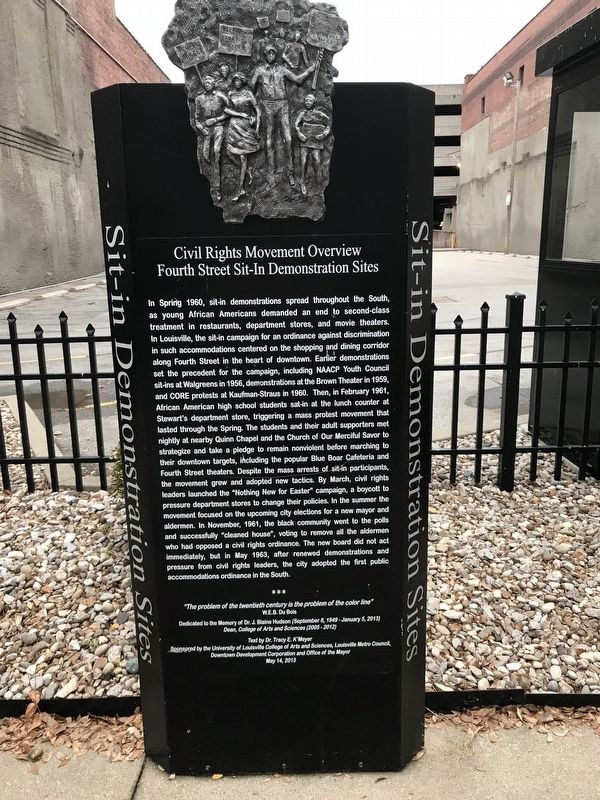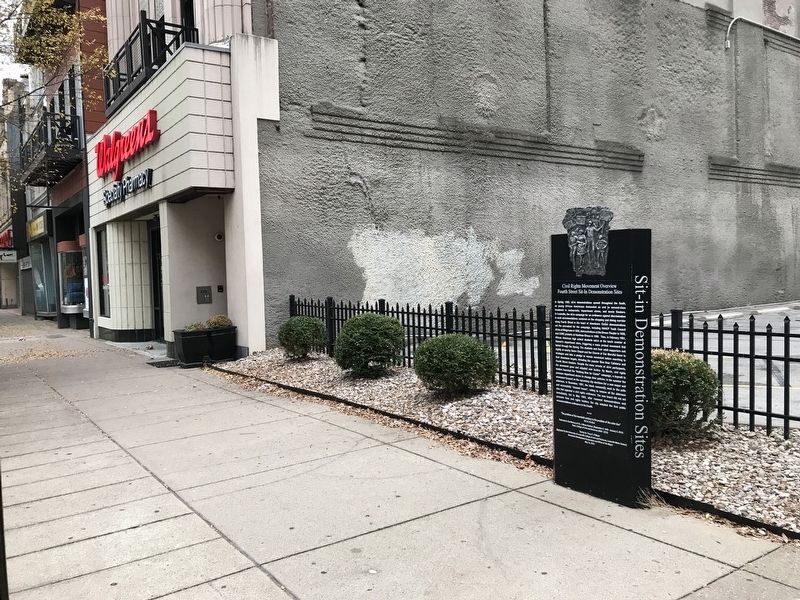Downtown in Louisville in Jefferson County, Kentucky — The American South (East South Central)
Civil Rights Movement Overview - Fourth Street Sit-In Demonstration Sites
Inscription.
In Spring 1960, sit-in demonstrations spread throughout the South, as young African Americans demanded an end to second-class treatment in restaurants, department stores, and movie theaters. In Louisville, the sit-in campaign for an ordinance against discrimination in such accommodations centered on the shopping and dining corridor along Fourth Street in the heart of downtown. Earlier demonstrations set the precedent for the campaign, including NAACP Youth Council sit-ins at Walgreens in 1956, demonstrations at the Brown Theater in 1959, and CORE protests at Kaufman-Straus in 1960. Then, in February 1961, African American high school students sat-in at the lunch counter at Stewart's department store, triggering a mass protest movement that lasted through the Spring. The students and their adult supporters met nightly at nearby Quinn Chapel and the Church of Our Merciful Savor to strategize and take a pledge to remain nonviolent before marching to their downtown targets, including the popular Blue Boar Cafeteria and Fourth Street theaters. Despite the mass arrests of sit-in participants, the movement grew and adopted new tactics. By March, civil rights leaders launched the “Nothing New for Easter” campaign, a boycott to pressure department stores to change their policies. In the summer the movement focused on the upcoming city elections for a new mayor and aldermen. In November, 1961, the black community went to the polls and successfully “cleaned house,” voting to remove all the aldermen who had opposed a civil rights ordinance. The new board did not act immediately, but in May 1963, after renewed demonstrations and pressure from civil rights leaders, the city adopted the first public accommodations ordinance in the South.
"The problem of the twentieth century is the problem of the color line"
W.E.B. Du Bois
Dedicated to the Memory of Dr. J. Blaine Hudson (September 8, 1949 - January 5, 2013)
Dean, College of Arts and Sciences (2005-2012)
Text by Dr. Tracy E. K'Meyer
Erected 2013 by University of Louisville College of Arts and Sciences; Louisville Metro Council; Downtown Development Corporation; and Office of the Mayor. (Marker Number 5.)
Topics. This historical marker is listed in these topic lists: African Americans • Civil Rights. A significant historical month for this entry is February 1961.
Location. 38° 15.013′ N, 85° 45.464′ W. Marker is in Louisville, Kentucky, in Jefferson County. It is in Downtown. Marker is on South 4th Street south of West Muhammad Ali Boulevard, on the right when traveling south. Touch for map.
Marker is at or near this postal address: 532 South 4th Street, Louisville KY 40202, United States of America. Touch for directions.
Other nearby markers. At least 8 other markers are within walking distance of this marker. Sit-in Demonstration Site (here, next to this marker); James Guthrie (1792-1869) (within shouting distance of this marker); Speed Building (within shouting distance of this marker); a different marker also named Sit-in Demonstration Site (about 300 feet away, measured in a direct line); The Seelbach Hotel, 1905 (about 300 feet away); Thomas Merton - (1915-68) / A Revelation (about 400 feet away); Campaign to End Racial Segregation in Louisville (about 400 feet away); Blue Boar Cafeteria (about 400 feet away). Touch for a list and map of all markers in Louisville.
Also see . . . Louisville Civil Rights Markers. (Submitted on August 3, 2021, by Shane Oliver of Richmond, Virginia.)
Credits. This page was last revised on February 12, 2023. It was originally submitted on December 1, 2020, by Duane and Tracy Marsteller of Murfreesboro, Tennessee. This page has been viewed 495 times since then and 45 times this year. Last updated on July 31, 2021, by Shane Oliver of Richmond, Virginia. Photos: 1. submitted on December 1, 2020, by Duane and Tracy Marsteller of Murfreesboro, Tennessee. 2. submitted on December 2, 2020, by Duane and Tracy Marsteller of Murfreesboro, Tennessee. • Devry Becker Jones was the editor who published this page.

